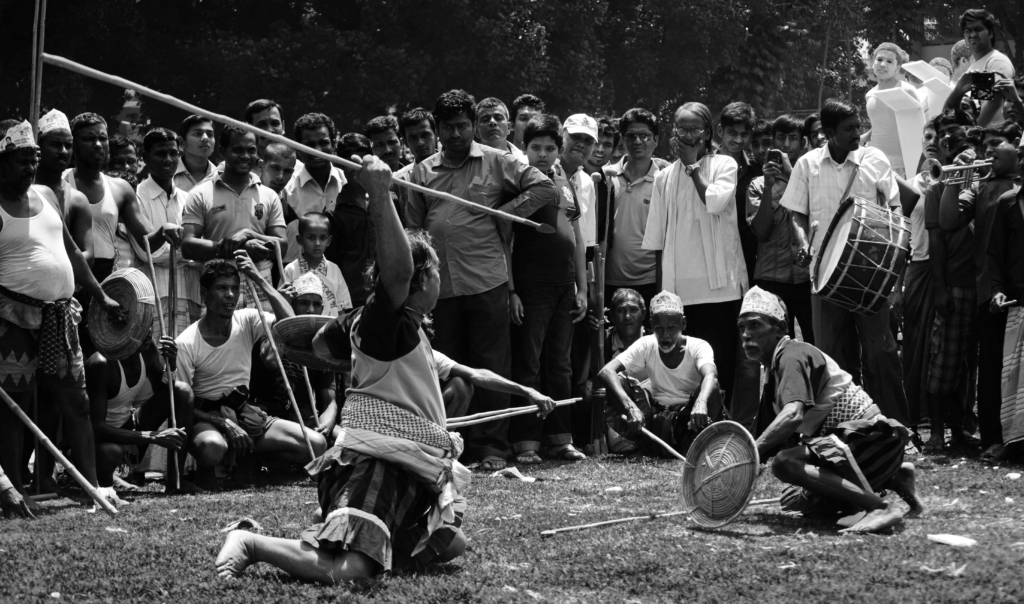Lathi Khela, or stick fighting, is an integral part of Bengal’s rural heritage. Deeply rooted in the cultural history of Bengal, it is not just a sport but also an ancient form of self-defense. Historically, Lathi Khela played a vital role in Bengali society, serving both as a means of entertainment and as a symbol of strength. Although its significance has waned in modern times, it remains closely intertwined with Bengal’s traditions and culture.
Origins and History of Lathi Khela
While the exact origins of Lathi Khela are unclear, it is believed to have been part of India’s ancient martial techniques. In Bengal, Lathi Khela became popular during the era of kings and zamindars (landlords). The zamindars often maintained private guards known as lathiyals, who protected their lands and villages using sticks as weapons. Due to restrictions on other types of weapons, the lathi (a bamboo or cane stick) was an accessible and powerful tool for defense.

During the colonial period, particularly in the face of British rule, lathiyals played a crucial role in local rebellions. Throughout the rural areas of Bengal, Lathi Khela became a method of training and honing combat skills, and the game became a display of power and strength across various regions.
Techniques and Types of Lathi Khela
The primary tool in Lathi Khela is the lathi, usually made from bamboo or cane and measuring about 5-6 feet in length. Players use it to defend against the opponent’s attacks while simultaneously launching their own offensive moves. A skilled lathiyal must possess quick reflexes, agility, balance, and sharp eyesight to block and counter attacks effectively.
Lathi Khela can be divided into two main aspects: defensive and offensive techniques. Defensive players must skillfully block or evade incoming strikes, while offensive players attempt to find gaps in the opponent’s defense and land successful hits. Various spinning techniques are used, including lifting the lathi from the ground and twirling it to deflect blows.
Physical stamina and endurance are vital for participants, as the game demands both strength and patience. Mastery of timing and precision in attack and defense differentiates an exceptional lathiyal from the rest.
Social and Cultural Influence of Lathi Khela
In rural Bengal, Lathi Khela was more than just a game; it symbolized power and authority. The lathiyals of village heads or zamindars maintained law and order and protected properties. They were often employed to resolve land disputes, and their strength was highly respected within the community. The strongest lathiyals earned significant prestige and even instilled fear in the common people.
Additionally, Lathi Khela was showcased during religious and social festivals. At village fairs, lathiyals demonstrated their skills, blending entertainment with local folklore. Accompanied by traditional instruments such as drums, conch shells, and flutes, these performances heightened the excitement of the game.
Lathi Khela in Modern Times
While modern sports and entertainment have reduced the popularity of Lathi Khela, it has not disappeared entirely. In some rural areas of Bengal, Lathi Khela is still practiced. Cultural events and fairs often feature demonstrations of this ancient sport, which continues to evoke the bravery, valor, and heritage of the Bengali people.

In recent years, training centers have emerged where the younger generation can learn Lathi Khela as a form of physical exercise and mental discipline. The sport remains a symbol of Bengal’s traditional values and is often promoted through various government and private initiatives aimed at preserving this heritage.
Conclusion
Lathi Khela is a proud part of Bengal’s cultural heritage, deeply entwined with its history and traditions. Although its prominence has declined with time, it remains a powerful reminder of the courage, strength, and unity of the Bengali people. Lathi Khela is not just a form of entertainment—it is a reflection of Bengal’s spirit of resistance and resilience. Preserving this ancient tradition is important for future generations, allowing them to appreciate and honor the bravery and legacy of their ancestors.

